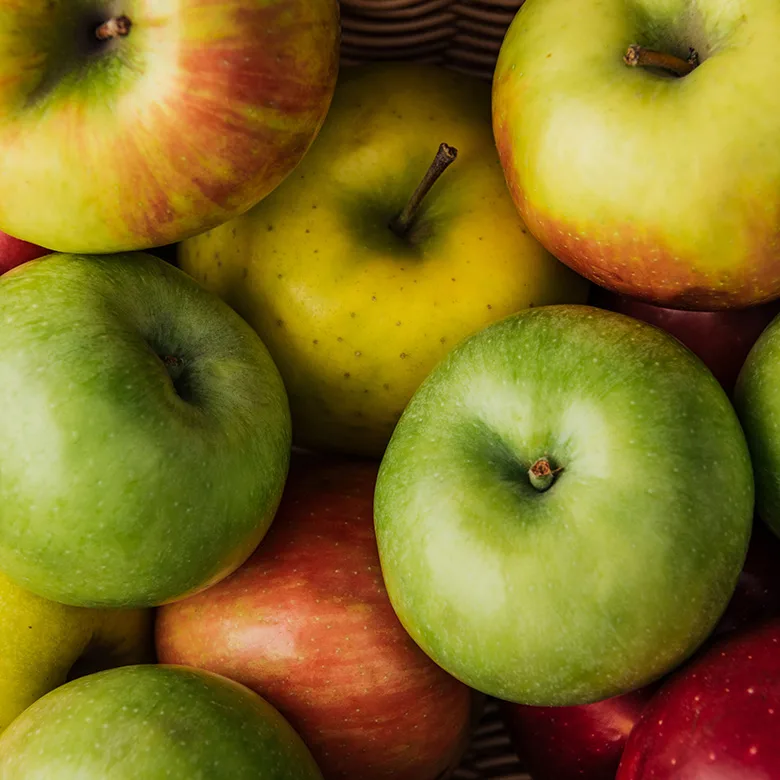The arrival of autumn’s incredible color palette goes hand in hand with the broad array of different apple varieties that pass through our produce department. Many of these are heirloom apples that offer complex flavors — along with a taste of history — you won’t find in your average grocery store.
Heirloom: A Brief Background
This term refers to varieties of apples that are not associated with large-scale commercial agriculture. In many cases, they have been passed down through generations, and sometimes predate the industrialization of agriculture. Unlike conventional apples, bred for uniformity and long shelf life, heirloom apples prioritize diversity of flavor, and often have rich historical significance.
In the 19th century, thousands of unique apple varieties flourished across America. As large-scale farming took hold, focus shifted to a handful of varieties that could better withstand shipping and offer consistent appearance — often at the cost of flavor.
Why Choose Organic Apples?
At the Co-op, we’re proud to offer a wide selection of organic apples, including a number of fascinating heirloom varieties. Here’s why choosing organic matters:
- Pesticide concerns: Apples consistently appear on the Environmental Working Group’s “Dirty Dozen,” a list of produce with the highest pesticide residues.
- Environmental impact: Organic apple growers use natural methods to manage pests and diseases, promoting soil health and biodiversity.
- Potential health benefits: Conventional apples are often treated with diphenylamine to prevent browning during storage. While the EPA considers this chemical safe, European regulators have banned its use due to concerns about potential carcinogenic compounds.
Heirloom Varieties at the Co-op
The arid climate in central Washington, combined with a well-developed irrigation system fed by the Columbia River, nutrient-rich volcanic soil, and an extended growing season, makes the state an ideal location to grow apples. In fact, well over 50 percent of the apples produced in the United States come from Washington.
We source many of our heirloom varieties from a cooperative of six small family farms in central Washington called Okanogan Producers Marketing Association. Certified organic by the Washington State Department of Agriculture, their values hold true to our own, and we are lucky to have their produce in our stores.
Due to smaller crop sizes, it’s impossible to predict exactly what varieties of apples we’ll see during apple season, but here are a few that we’re excited about:
NY 428 – Cornell University – 1962
Although its lackluster name and squat, lopsided appearance don’t make it obvious, this variety, developed by Cornell University’s apple breeding program, offers an incredibly deep profile of sweet and tart flavors that sharply contrast its generic red color. A cross between the Empire and Northern Spy varieties, it has a crisp texture that makes it ideal for both fresh eating and cooking.
Wagener – New York’s Finger Lake region – Early 1800s
This lovely yellow apple has thinner skin that develops a bloom — a protective waxy film the apple produces. It is juicy, aromatic, and tender, making it as good for eating as it is for apple sauce and pies, which highlight its intense flavors.
Crimson Crisp – Rutgers Fruit Research and Development Center in Cream Ridge, New Jersey – 1971
A 2005 introduction makes this a relatively recent variety, even though development actually started back in 1971. A cooperative breeding program between Purdue, Rutgers, and Illinois State universities wanted to create an apple that had strong disease resistance and flavor. As its name implies, it is dark red in color, and crunchy. It is extremely juicy, slightly tart, and spicy — perfect for eating.
Spartan – Canada Agriculture Research Station in Summerland, British Columbia – 1920s
The Spartan is a cross between McIntosh and what was thought to be a Newtown Pippin — although modern DNA analysis has revealed that there is no Newtown Pippin in its genes. This red apple has a fine-grained, crisp texture and a sweet flavor, great for eating and juicing.
Nickajack – Likely originated with the Cherokee Nation near Nickajack Creek, North Carolina – 1700s
This pre-Civil War variety has greenish-yellow skin brushed with orange or red stripes, and develops a light bloom — that protective, waxy coating — when it matures. It is known for its large size and sweet-tart flavor, and is good for both fresh eating and cooking.
This list is far from exhaustive — our heirloom apple selection changes regularly throughout the season, offering a rotating cast of unique flavors and textures. Each has its own story and distinctive taste profile, from sweet to tart, crisp to tender.
Every variety is a small taste of history, a celebration of biodiversity, and a step toward a more sustainable food system. Many of them won’t grace our shelves for more than a week or two, so whether you’re baking a pie, preparing a cheese board, or just enjoying a crisp snack, stop by and find an heirloom apple variety that will elevate your day.
